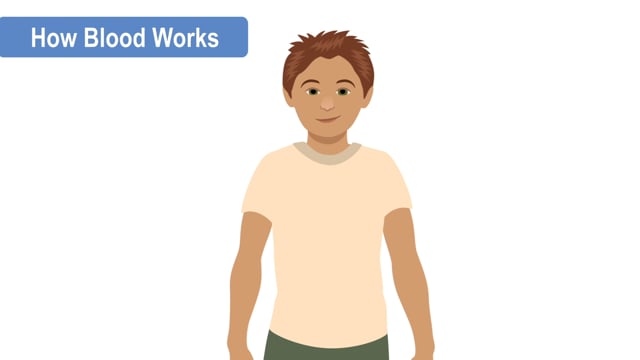Blood Transfusions
What Is a Blood Transfusion?
A blood transfusion is when a donor's blood is given to a patient. Blood transfusions save lives every day. Hospitals use them to help people who are injured, having surgery, getting cancer treatments, or being treated for other diseases that affect the blood, like sickle cell anemia.
What Is Blood Made of?
Blood is a mixture of cells and liquid, and each part has a specific job:
- Red blood cells carry oxygen to the body's tissues and remove carbon dioxide. These cells are the ones that are most commonly transfused.
- White blood cells help the body fight infection.
- Platelets, the smallest blood cells, help to clot the blood and control bleeding.
- Plasma, the pale yellow liquid part of blood, is a mix of water, proteins, electrolytes, carbohydrates, cholesterol, hormones, and vitamins.

How Blood Works
Blood helps the parts of our body work as they should. In this video, learn how blood brings oxygen and nutrients around the body and helps fight off infections.
Why Do People Need a Transfusion?
A person may need a blood transfusion if:
- They lost blood during surgery or from an injury or an illness.
- Their body doesn't make enough blood. Some illnesses and treatments can prevent the bone marrow from making blood (for example, chemotherapy lowers production of new blood cells).
- They are at risk for problems from a blood or bleeding disorder, such as sickle cell disease, thalassemia, or anemia caused by kidney disease, hemophilia, or von Willebrand disease.
What Are Blood Types?
Blood from a donor needs to match the blood type of the person receiving it. There are 8 main blood types:
- O positive
- O negative
- A positive
- A negative
- B positive
- B negative
- AB positive
- AB negative
In emergencies, there are exceptions to the rule that the donor's blood type must match the recipient's exactly. O negative is the only blood type that people of all other blood types can receive. Medical teams use it in situations when patients need a transfusion but their blood type is unknown. Because of this, O negative donors are "universal donors." People who have type AB positive blood are "universal recipients" because they can safely receive any type of blood.
A blood transfusion usually isn't whole blood — it could be any one of the blood's parts. For example, chemotherapy can affect how bone marrow makes new blood cells. So some people getting treatment for cancer might need a transfusion of red blood cells or platelets.
Other people might need plasma or only certain parts of plasma. People who have hemophilia, a disease that affects the blood's ability to clot, need plasma or the clotting factors contained in plasma to help their blood clot and prevent bleeding.
Where Does the Blood Come From?
Because there's no substitute for blood, the blood supply used for transfusion must be donated. Blood donation types include:
- Autologous (pronounced: ah-TOL-uh-gus) blood donation. This is when someone donates their own blood ahead of time for a planned surgery or other procedure.
- Directed donation. This is when a family member or friend with a compatible (good fit) blood type donates blood specifically for use by a patient in need of transfusion.
- Volunteer donation. Most patients get blood donated through blood drives. These are often run by agencies like the American Red Cross. The minimum age for donating blood is 16 or 17 years old, depending on where a person lives.
What Happens During a Blood Transfusion?
When someone gets a transfusion:
- A needle is used to place a tiny plastic tube into a vein. The needle is then removed.
- A plastic bag containing the blood is connected to the tube. The blood slowly flows from the bag, through the tube, into the vein.
- Their vital signs (temperature, blood pressure, and heart rate) are checked before, during, and after the transfusion.
- A nurse watches for any signs of an allergic or other type of reaction, including rash, fever, headache, or swelling.
Transfusions usually take 1 to 4 hours, depending on how much blood is given and the person's blood type. Someone getting a transfusion can sit comfortably in a reclining chair or lie down on a bed, watch a movie, listen to music, or play quietly, and might be able to eat and drink, walk around a bit, and use the bathroom.
After the transfusion, the plastic tube is removed from the vein and a bandage is placed over the area. The site may be slightly sore or tingly for a little while. The person might get medicine for any mild side effects, such as fever or headache.
Are There Any Risks to Blood Transfusions?
Some people worry about getting diseases from infected blood, but most countries have safety steps in place to prevent transfusing infected blood.
In the United States, all blood donors must give a detailed history, including recent travel, infections, medicines, and health problems. Also, the American Red Cross and other donation groups test donated blood for viruses like HIV (the virus that causes AIDS), hepatitis B, hepatitis C, syphilis, and West Nile virus. Because blood can also be infected with bacteria or parasites, some blood components also get tested for these. Blood that contains any of these things is destroyed.
Also, the needles and other equipment are sterile, and they're used only for one person and then thrown away in special containers.
What Are the Benefits of Blood Transfusions?
In people with anemia or those getting chemotherapy, the greatest benefit of a transfusion is increased blood flow to nourish the organs and improve oxygen levels in the body. This can keep them from feeling too tired and help give them enough energy for the activities of daily life. Benefits like this often are felt fairly quickly.
For patients with bleeding problems, transfusions with platelets or plasma can help to control or prevent bleeding problems.
The Red Cross estimates that 20% of all blood donors in the United States are high school or college students. If you are eligible and wish to donate blood, contact your local blood bank or the American Red Cross for more information on what's involved. You could help save someone's life.
Reviewed by: Larissa Hirsch, MD
Date Reviewed: Jun 10, 2022
















